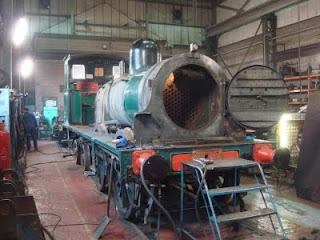
Dunrobin Developments 2
3rd June 2011
Here is an update on the stripping of Dunrobin at Bridgnorth. It is always nice to walk into a room and see a project look markedly different – and sans tanks, Dunrobin really does look unfamiliar! Duncan Ballard and his team are progressing well and each new stage opens up more questions or reveals more information about the engine and its history.
Meanwhile, I am gathering all that I possibly can relating to its history, which will be compiled in the Conservation Management Plan. I think I have now drawn my own conclusion that Dunrobin, built in 1895, was essentially preserved in 1895! The limiting of its operation to maybe a dozen times per year (excluding the war years) and manner in which it was cosseted and never substantially rebuilt (if it has ever had a heavy overhaul at all) support such a description – which is nice (and indeed rare) to find in a steam locomotive – it really is almost totally original, and that which might have perished or been patched is sound and in good order, such as the tanks and cab/bunkers…
So, what has been happening?
Below: The first impression, with splashers, tanks and cab roof removed.
Below: The tanks, which appear to be in very good condition.
Below: An unfamiliar view from the cab, with backhead fittings also removed.
Below: In an effort to trace the original livery, I rubbed down the front of one of the tanks – to reveal, beneath the primer of the later sprayed green – bare metal! This suggests the tanks were sand blasted in recent years or wet stripped before repainting.
Below: Duncan Ballard at work as a start is made on removing the tubes.
Below: The removal of the tanks enables a closer view of the Canadian lubrication system, set up to enable preparation of the engine without a pit. Mechanical lubricators were fitted to pump oil to inverted triangular dishes, which used a wick (possibly out of oil lamps) to carry oil to the lubricating pots, in turn fitted with small angled plates to capture the oil from the wicks – something that is often seen on stationary engines. We will be reverting to pot and wick lubrication on the engine and the mechanical lubricators have now been removed.
Below: Another view inside the works.
Below: An unusual cab view! Hopefully this area can remain untouched as part of the overhaul as the bunker and supplementary tanks appear to be in good order.
Below: A general view of the boiler from the firebox end.
Below: Removal of the buckeye coupler plates and a little rubbing back enabled the position and to some extent colour of the original buffer beam and panel to be identified, as seen below. Note the later application (to the right) is at a different level to that obscured by the plate – all of this is valuable information when informing the CMP and how we decide to approach the restoration of the locomotive (and likewise the carriage).







Recent Comments